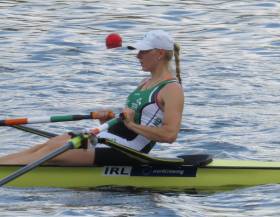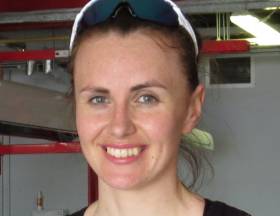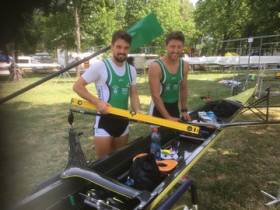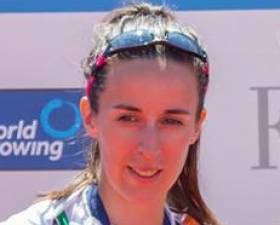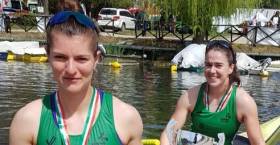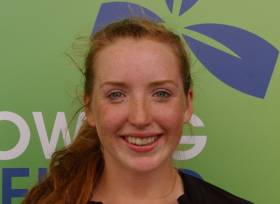Displaying items by tag: World Cup
#Rowing: Sanita Puspure took second in her semi-final and qualified for the A Final of the single sculls at the World Cup regatta in Belgrade, Serbia. Denmark’s Fie-Udby Erichsen took over the lead early and won, with Puspure and Kara Kohler of the United States not far behind as they crossed halfway. However, the anticipated move from Vicky Thornley of Britain upset the order. She pushed up beside Puspure, who held on to second. Kohler missed out and finished fourth.
World Cup Regatta, Belgrade, Day Two (Irish interest)
Men
Pair – C Final (Places 13 to 18): 1 Hungary 6:55.35, 2 Greece 6:57.73, 3 Ireland (M O’Donovan, S O’Driscoll) 6:59.0, 4 South Africa 7:00.22.
Women
Pair – Semi-Final Two (Three to A Final; rest to B Final): 1 Spain 7:35.18, 2 Denmark 7:35.77, 3 Britain Two 7:39.35; 4 Ireland (A Keogh, E Hegarty) 7:42.60.
Double Sculls – Semi-Final (Three to A Final; rest to B Final): Netherlands 7:16.27, 2 Belarus One 7:18.73, 3 Belarus Two 7:23.46; 4 Ireland (A Crowley, M Dukarska) 7:25.60.
Single Sculls – Semi-Final (Three to A Final; rest to B Final): 1 Denmark (F Erichsen) 7:24.76, 2 Ireland (S Puspure) 7:25.43, 3 Britain (V Thornley) 7:25.78.
#Rowing: Emily Hegarty and Aifric Keogh took fourth in their semi-final of the women’s pair at the World Cup Regatta in Belgrade. The two UCC women closed hard in the closing stages on Britain Two, but the British crew of Emily Ford and Emily Ashford held on to the third place which sends them to the A Final. Spain won from Denmark.
The result for the Ireland double of Monika Dukarska and Aileen Crowley was the same. They started well in their semi-final and led to the 500 metre mark. The Netherlands and Belarus One took over and held those places to the end. Belarus Two established themselves in the third qualification spot and Dukarska and Crowley, who finished fast, could not dislodge the second Belarus boat.
The Ireland pair and double will compete in B Finals.
World Cup Regatta, Belgrade, Day Two (Irish interest)
Men
Pair – C Final (Places 13 to 18): 1 Hungary 6:55.35, 2 Greece 6:57.73, 3 Ireland (M O’Donovan, S O’Driscoll) 6:59.0, 4 South Africa 7:00.22.
Women
Pair – Semi-Final Two (Three to A Final; rest to B Final): 1 Spain 7:35.18, 2 Denmark 7:35.77, 3 Britain Two 7:39.35; 4 Ireland (A Keogh, E Hegarty) 7:42.60.
Double Sculls – Semi-Final (Three to A Final; rest to B Final): Netherlands 7:16.27, 2 Belarus One 7:18.73, 3 Belarus Two 7:23.46; 4 Ireland (A Crowley, M Dukarska) 7:25.60.
#Rowing: Mark O’Donovan and Shane O’Driscoll took third place in their C Final of the men’s pair at the World Cup in Belgrade this morning. This was an extraordinary race. Britain Two, South Africa, Ireland and Greece moved as a pack through halfway and the 1500 metres. Greece then took over in the lead, with Ireland also contending. But Hungary, which had hung in sixth and fifth place through most of the 2,000 metres, finished best. They passed the leaders and won, with Greece and Ireland next over the line.
The placing put O’Donovan and O’Driscoll 15th of the 22 crews which raced.
World Cup Regatta, Belgrade, Day Two (Irish interest)
Men
Pair – C Final (Places 13 to 18): 1 Hungary 6:55.35, 2 Greece 6:57.73, 3 Ireland (M O’Donovan, S O’Driscoll) 6:59.0, 4 South Africa 7:00.22.
#Rowing: Mark O’Donovan and Shane O’Driscoll finished third in their repechage and qualified for the C Final of the men’s pair at the World Cup regatta in Belgrade. The first two boats over the line qualified for A/B Semi-Finals, and the Netherlands One, which won well, and Netherlands Two took these spots. O’Donovan and O’Driscoll pushed hard to break into the top two, with a very high rate of striking, but even though they did not do this, their fast finish helped them win a battle with South Africa to take third and secure a place in the C Final (places 13 to 18).
World Cup Regatta, Belgrade (Irish interest)
Men
Pair – Heat Four (Winner to A/B Semi-Finals; rest to repechage): 1 Czech Republic 6:41.22; 2 Spain 6:48.03, 3 China One 6:51.79, 4 Ireland (M O’Donovan, S O’Driscoll) 6:51.91. Repechage Three (First Two to A/B Semi-Finals; third to C Final; rest to C or D Final): 1 Netherlands One 6:48.68, 2 Netherlands Two 6:50.07; 3 Ireland 6:51.82.
Lightweight Double Sculls – Heat Three (First two to A/B Semi-Finals; rest to repechage): 1 Canada Two 6:32.69, 2 Ireland (G O’Donovan, P O’Donovan) 6:34.29.
Women
Pair – Heat One (First Three to A/B Semi-Finals; rest to repechage): 1 Britain One 7:19.05, 2 Britain Two 7:22.92, 3 Ireland (A Keogh, E Hegarty) 7:23.77.
Double Sculls – Heat Three (First Three to A/B Semi-Finals; rest to repechage): 1 Netherlands 7:10.90, 2 China One 7:16.89, 3 Ireland (A Crowley, M Dukarska) 7:20.40.
Lightweight Double Sculls – Heat One (First two to A/B Semi-Finals; rest to repechage): 1 Britain One 7:26.96, 2 United States One 7:28.40; 5 Ireland (M Cremen, D Walsh) 7:50.34.
Single Sculls – Heat One (First Two to A/B Semi-Finals; rest to repechage): 1 Ireland (S Puspure) 7:50.48, 2 Ukraine (D Dymchenko) 7:59.30.
#Rowing: Paul O’Donovan and Gary O’Donovan secured a semi-final place with second in their heat of the lightweight double sculls at the World Cup regatta in Belgrade. Patrick Keane and Maxwell Lattimer, the Canada Two crew, won the race. They fought off Portugal and then kept Ireland at bay, winning by 1.6 seconds.
World Cup Regatta, Belgrade (Irish interest)
Men
Pair – Heat Four (Winner to A/B Semi-Finals; rest to repechage): 1 Czech Republic 6:41.22; 2 Spain 6:48.03, 3 China One 6:51.79, 4 Ireland (M O’Donovan, S O’Driscoll) 6:51.91.
Lightweight Double Sculls – Heat Three (First two to A/B Semi-Finals; rest to repechage): 1 Canada Two 6:32.69, 2 Ireland (G O’Donovan, P O’Donovan) 6:34.29.
Women
Pair – Heat One (First Three to A/B Semi-Finals; rest to repechage): 1 Britain One 7:19.05, 2 Britain Two 7:22.92, 3 Ireland (A Keogh, E Hegarty) 7:23.77.
Double Sculls – Heat Three (First Three to A/B Semi-Finals; rest to repechage): 1 Netherlands 7:10.90, 2 China One 7:16.89, 3 Ireland (A Crowley, M Dukarska) 7:20.40.
Lightweight Double Sculls – Heat One (First two to A/B Semi-Finals; rest to repechage): 1 Britain One 7:26.96, 2 United States One 7:28.40; 5 Ireland (M Cremen, D Walsh) 7:50.34.
Single Sculls – Heat One (First Two to A/B Semi-Finals; rest to repechage): 1 Ireland (S Puspure) 7:50.48, 2 Ukraine (D Dymchenko) 7:59.30.
Walsh and Cremen Set for Repechage at World Cup
#Rowing: Denise Walsh and Margaret Cremen finished fifth in their heat of the lightweight double sculls at the World Cup Regatta in Belgrade and must compete in a repechage as they seek a semi-final place. There were just two places on offer in the heat and Britain One and the United States One asserted control early on and took them in that order. Ireland found themselves behind four crews from early on in the race and the order did not change.
World Cup Regatta, Belgrade (Irish interest)
Men
Pair – Heat Four (Winner to A/B Semi-Finals; rest to repechage): 1 Czech Republic 6:41.22; 2 Spain 6:48.03, 3 China One 6:51.79, 4 Ireland (M O’Donovan, S O’Driscoll) 6:51.91.
Women
Pair – Heat One (First Three to A/B Semi-Finals; rest to repechage): 1 Britain One 7:19.05, 2 Britain Two 7:22.92, 3 Ireland (A Keogh, E Hegarty) 7:23.77.
Double Sculls – Heat Three (First Three to A/B Semi-Finals; rest to repechage): 1 Netherlands 7:10.90, 2 China One 7:16.89, 3 Ireland (A Crowley, M Dukarska) 7:20.40.
Lightweight Double Sculls – Heat One (First two to A/B Semi-Finals; rest to repechage): 1 Britain One 7:26.96, 2 United States One 7:28.40; 5 Ireland (M Cremen, D Walsh) 7:50.34.
Single Sculls – Heat One (First Two to A/B Semi-Finals; rest to repechage): 1 Ireland (S Puspure) 7:50.48, 2 Ukraine (D Dymchenko) 7:59.30.
Puspure Opens With Commanding Win at World Cup Rowing
#Rowing: Sanita Puspure booked her places in the semi-finals of the World Cup in Belgrade with a commanding win in her heat. The Ireland single sculler had a slight lead by the 500 metre mark over Diana Dymchenko of the Ukraine. Puspure extended her advantage by halfway and then moved clear in the second 1,000 metres. Carling Zeeman of Canada tried to push into the second – and final – qualifying spot but could not get past Dymchenko, who finished almost nine seconds behind Puspure.
World Cup Regatta, Belgrade (Irish interest)
Men
Pair – Heat Four (Winner to A/B Semi-Finals; rest to repechage): 1 Czech Republic 6:41.22; 2 Spain 6:48.03, 3 China One 6:51.79, 4 Ireland (M O’Donovan, S O’Driscoll) 6:51.91.
Women
Pair – Heat One (First Three to A/B Semi-Finals; rest to repechage): 1 Britain One 7:19.05, 2 Britain Two 7:22.92, 3 Ireland (A Keogh, E Hegarty) 7:23.77.
Double Sculls – Heat Three (First Three to A/B Semi-Finals; rest to repechage): 1 Netherlands 7:10.90, 2 China One 7:16.89, 3 Ireland (A Crowley, M Dukarska) 7:20.40.
Single Sculls – Heat One (First Two to A/B Semi-Finals; rest to repechage): 1 Ireland (S Puspure) 7:50.48, 2 Ukraine (D Dymchenko) 7:59.30.
#Rowing: Ireland’s women’s double scull of Aileen Crowley and Monika Dukarska qualified directly for the semi-finals of the World Cup in Belgrade this morning. They took the third of the three places of offer in their heat. The Netherlands won well and China One, who had led in the first quarter, took second. Dukarska and Crowley were third through most of the race but had just 3.4 seconds to spare over Switzerland at the finish line.
World Cup Regatta, Belgrade (Irish interest)
Men
Pair – Heat Four (Winner to A/B Semi-Finals; rest to repechage):
1 Czech Republic 6:41.22; 2 Spain 6:48.03, 3 China One 6:51.79, 4 Ireland (M O’Donovan, S O’Driscoll) 6:51.91.
Women
Pair – Heat One (First Three to A/B Semi-Finals; rest to repechage): 1 Britain One 7:19.05, 2 Britain Two 7:22.92, 3 Ireland (A Keogh, E Hegarty) 7:23.77.
Double Sculls – Heat Three (First Three to A/B Semi-Finals; rest to repechage): 1 Netherlands 7:10.90, 2 China One 7:16.89, 3 Ireland (A Crowley, M Dukarska) 7:20.40.
#Rowing: Mark O’Donovan and Shane O’Driscoll took fourth in their heat of the pair at the World Cup Regatta in Belgrade this morning. Only the winner nailed down a place in the semi-final and the Czech Republic took this after a battle with Spain. Well behind them, China One won their battle with O’Donovan and O’Driscoll.
The Irish, the world champions in the lightweight pair, are hoping to establish themselves as a heavyweight pair. They were 13th of the 22 contenders on time.
World Cup Regatta, Belgrade (Irish interest)
Men
Pair – Heat Four (Winner to A/B Semi-Finals; rest to repechage):
1 Czech Republic 6:41.22; 2 Spain 6:48.03, 3 China One 6:51.79, 4 Ireland (M O’Donovan, S O’Driscoll) 6:51.91.
Women
Pair – Heat One (First Three to A/B Semi-Finals; rest to repechage): 1 Britain One 7:19.05, 2 Britain Two 7:22.92, 3 Ireland (A Keogh, E Hegarty) 7:23.77.
#Rowing: Ireland’s new pair of Emily Hegarty and Aifric Keogh put in a decisive sprint in the final 200 metres to take a crucial third place in their heat at the World Cup Regatta in Belgrade this morning. Britain took the first two qualification places for the semi-finals. For much of the race, Serbia held third, with Ireland lagging behind by over a length in fourth and set to go to a repechage. However, Ireland finished well and passed the hosts.
World Cup Regatta, Belgrade (Irish interest)
Women
Pair – Heat One (First Three to A/B Semi-Finals; rest to repechage): 1 Britain One 7:19.05, 2 Britain Two 7:22.92, 3 Ireland (A Keogh, E Hegarty) 7:23.77.


























